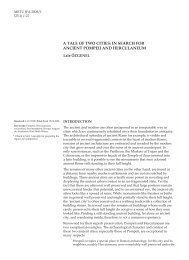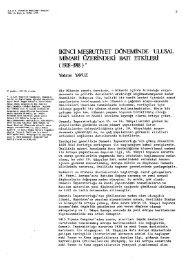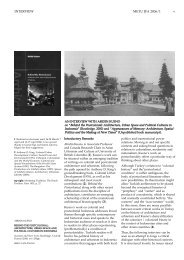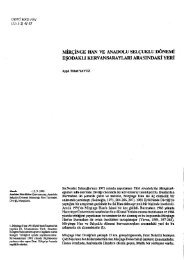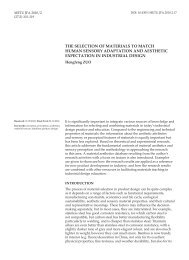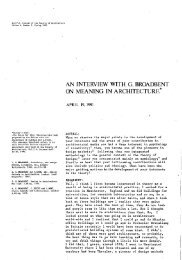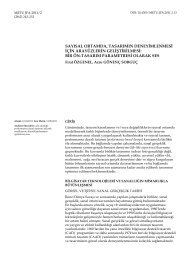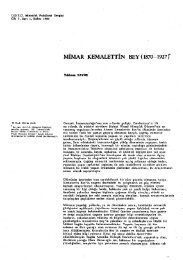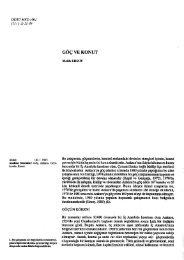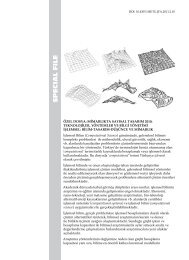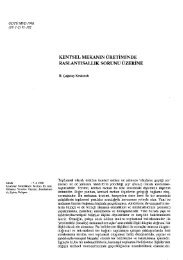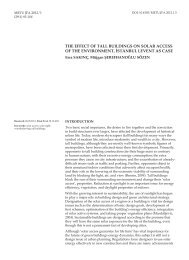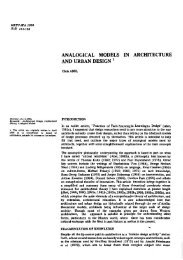taşı taş gibi, ahşabı ahşap gibi göstermek - Journal of the Faculty of ...
taşı taş gibi, ahşabı ahşap gibi göstermek - Journal of the Faculty of ...
taşı taş gibi, ahşabı ahşap gibi göstermek - Journal of the Faculty of ...
Create successful ePaper yourself
Turn your PDF publications into a flip-book with our unique Google optimized e-Paper software.
FRANK LLOYD WRIGHT’IN MALZEME TEORİSİ METU JFA 2012/1 337<br />
Received: 23.08.2011, Final Text: 10.05.2012<br />
Keywords: nature <strong>of</strong> <strong>the</strong> material; Frank<br />
Lloyd Wright; Fallingwater House; Taliesin<br />
House and Studio; Carlo Lodoli; Jean-<br />
Nicolas-Louis Durand; Viollet-le-Duc.<br />
VIOLLET-LE-DUC, E.-E. (1889) Discourses on Architecture, çev. Benjamin<br />
Bucknall, Ticknor and Company, Boston.<br />
VITRUVIUS (1999) Ten Books on Architecture, çev. I. D. Rowland, T. N.<br />
Howe, and M. J. Dewar, Cambridge University Press, Cambridge,<br />
New York.<br />
WRIGHT, F.L. (1932) An Autobiography, Longmans, Green, London, New<br />
York, Toronto.<br />
WRIGHT, F. L. (1954) Natural House, Horizon Press, New York.<br />
WRIGHT, F. L. (1975) In <strong>the</strong> Cause <strong>of</strong> Architecture, Architectural Record<br />
Books, New York.<br />
WRIGHT, F. L. (1995) Frank Lloyd Wright Collected Writings Voume 5: 1949-<br />
1959, der. B. B. Pfeiffer, Rizzoli, New York.<br />
“LET THE STONE APPEAR AS STONE, WOOD AS WOOD”:<br />
FRANK LLOYD WRIGHT’S THEORY OF MATERIALS<br />
Frank Lloyd Wright’s stance on <strong>the</strong> subject addressed in this essay seems<br />
unequivocal: “Architecture is in <strong>the</strong> nature <strong>of</strong> materials.” Throughout his<br />
prolific career, he argued that every material has its own nature, which<br />
should be known, conformed to, and frankly expressed by <strong>the</strong> designer.<br />
The designer’s task, he argued, was to develop <strong>the</strong> material into <strong>the</strong> form,<br />
proportion, and ornamentation that is inherent in <strong>the</strong> material itself,<br />
instead <strong>of</strong> imposing forms upon it. A correct use <strong>of</strong> <strong>the</strong> material that<br />
abided by its intrinsic nature would determine <strong>the</strong> image <strong>of</strong> <strong>the</strong> building,<br />
as each material suggested its own plan type, construction technique, and<br />
appearance. Why should modern architects proceed in this way? Wright<br />
felt this method would allow <strong>the</strong>m to overcome <strong>the</strong> historicist and eclectic<br />
attitude that prevailed in <strong>the</strong> previous century. And he was not alone in<br />
thinking this; his premises were accepted and restated by many o<strong>the</strong>r<br />
pioneers <strong>of</strong> twentieth century architecture. Advanced as a central tenet <strong>of</strong><br />
modernism, it eventually became <strong>the</strong> conventional understanding <strong>of</strong> <strong>the</strong><br />
material qualities, and remains so today— well-established and <strong>of</strong>tenrepeated.<br />
Given this broad acceptance, it is perhaps not surprising that <strong>the</strong><br />
content, origins, implications, and understanding <strong>of</strong> “nature” and “design”<br />
assumed in this truism have rarely been questioned. Yet, <strong>the</strong> idea that<br />
every material has its own independent, transparent and constant nature<br />
that should be expressed through design and construction was unknown<br />
in <strong>the</strong> history <strong>of</strong> architecture before <strong>the</strong> seventeenth century. Nei<strong>the</strong>r<br />
Vitruvius nor Alberti, whose treatments <strong>of</strong> materials were very thorough,<br />
ever mentioned <strong>the</strong> “nature <strong>of</strong> <strong>the</strong> materials” and <strong>the</strong>ir “true expression.”<br />
But that does not mean this notion was original or specific to twentieth<br />
century architectural thought. While presented as a ground-breaking<br />
discovery by Frank Lloyd Wright, it was, in fact, put forth and developed<br />
by several European architects from <strong>the</strong> seventeenth century onwards.<br />
This paper explores Frank Lloyd Wright’s idea that design should be true<br />
to <strong>the</strong> nature <strong>of</strong> materials. The study is both historical and <strong>the</strong>oretical;<br />
it considers Wright’s architectural practice, and <strong>of</strong>fers an analysis <strong>of</strong><br />
its precedents. The first part <strong>of</strong> <strong>the</strong> essay examines Wright’s writings,



